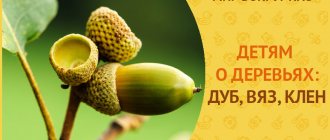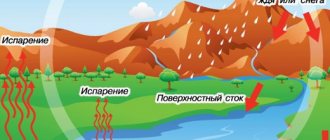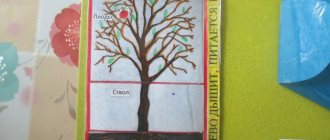Deciduous trees
Let's get acquainted with the main types of deciduous trees that are found in cities, forests and parks of our country.
Birch
The most beloved tree in Russia is often called the “tree of life”, “Russian beauty”, “bride”. Birch is easily recognized by its trunk, covered with almost white bark - birch bark. The leaves of the birch are not large, the crown is not too thick, it allows light to pass through, so it is rarely dark in the birch forest.
This tree grows throughout Russia - and not only. Due to its unpretentiousness, birch is found everywhere in the Northern Hemisphere and even beyond the Arctic Circle. Dwarf birch grows in the tundra - less than 1 meter tall.
An ordinary birch grows up to 15 meters and even higher - up to 30. The tree lives for about 100 years.
Birch flowers are called “catkins”; they look more like soft flexible hanging cones than flowers.
Birch is one of the most useful trees growing in our climate. Its leaves contain many healing substances, so they are used both in the form of decoctions and for preparing infusions that help with various diseases and as a general tonic. Birch sap is tasty and healthy. Bath brooms are made from birch branches and leaves, which promote the healing of wounds and abrasions. And even the smell of birch is believed to “heal from the evil eye and bad mood.”
Since ancient times, the top layer of birch bark - birch bark - has been widely used. Since it is resistant to dampness, it was used in construction; and in everyday life they were used to make household utensils. “Birch bark letters”—records made on bark—have survived to this day. They are of great interest primarily for historians involved in the study of Ancient Rus'.
Linden
The ancient Slavs said that the linden tree is “the mother tree: it feeds, puts on shoes, and heals.” But linden grows not only in Russia; it can be found in many European countries, even in the north (Norway, Finland). Although most of all linden loves a warm and fairly humid climate.
This tree can be found both in gardens and parks, as well as in forests and fields.
It is easy to distinguish - by its reddish branches and leaves, which have a characteristic round shape with small teeth. The crown of the linden tree is not as delicate as that of the birch tree; it creates a thick, cool shadow. Linden can reach 30 meters in height.
Linden shows itself most clearly during flowering. At the end of June - July, the entire tree is covered with beautiful light yellow inflorescences, emitting a strong honey aroma. In addition to their beautiful appearance, linden flowers have good disinfectant properties.
But the young plant does not bloom immediately. A linden tree planted artificially begins to bloom only after 30 years; under natural conditions - 10 years earlier. In general, linden lives for quite a long time, up to 400 years, but there are known cases of “long-living trees” that are 1000 years old or even more.
Linden seeds are small, similar to peas, which are collected in several pieces on one stalk equipped with a light “wing”. These wings help the seeds scatter, and the seeds themselves serve as food for birds.
The Slavs have long used linden in a variety of ways: cutlery and dishes were made from the wood, bast shoes were woven from the bark, and linden blossom was used to treat many diseases.
Linden is one of the most useful honey plants; honey is called "Lipets". And the tree itself got its name from its sticky buds and leaves.
Oak
“Oak-giant”, “oak-giant”. It is no coincidence that people and literature associate this tree with strength and power. The oak looks the part: a large, mighty tree with an immense trunk and a rich crown. The tree reaches 40 meters, but does not grow throughout its life: at the age of 100-200 years, growth in height stops. A slight increase in width continues throughout the life of the tree, but it lives for a long time, sometimes up to 2 thousand years!
Oak leaves have a beautiful intricate shape with rounded teeth. The bark is strong and thick, dark in color.
The oak is one of the last to leaf out in the forest - sometimes closer to the beginning of summer. And it blooms immediately. Its flowers are located on long hanging “earrings”.
All children love and know oak fruits. These are acorns - cute oblong nuts hanging on their caps. They can be eaten.
Acorn coffee is a fairly common drink in the world. And in their raw form, pigs and wild boars enjoy eating acorns.
Oak bark, which contains tannins and natural antiseptics, is widely used in medicine.
Oak wood is one of the most sought after and valuable in the world.
Previously, oak was also used in ink production: from the so-called “galls” or “ink nuts” (balls that form on oak leaves due to the interaction of tannins with substances secreted by special larvae living on the tree) paint was extracted, which was included in composition of permanent ink. In Pushkin's time they wrote with exactly this ink.
Maple
When you think of this tree, the first thing that comes to mind is its leaves. They are actually very beautiful - and absolutely original, with five sharp, curly “fingers”. Maple leaves are especially picturesque in the fall, when they turn all shades of yellow and red. And maple seeds look like dragonflies with their transparent, light wings.
The tree itself is quite large, it can grow up to 30 meters in height and up to one and a half meters in diameter. In general, maple grows very quickly.
There are more than 100 species of maple in the world. Norway Maple is the most common species in our country. And in Canada, the maple tree is a national favorite; the leaf design even adorns the national flag. By the way, the Canadian maple lives much longer than “ours”: up to 500 years, whereas in our forests it lives only up to 200.
Maple loves illuminated areas, so there are practically no pure maple forests - the tree grows mainly on the edges. The maple tree blooms in May with medium-sized yellow-green flowers.
Maple syrup is very popular in Canada and North America. It is obtained from tree sap. But there is no point in trying to get it from our maples - it can only be obtained from a special variety. Although our maples also produce juice, it is not as tasty, but it is used in medicine to strengthen the immune system and treat nerves. Maple leaves have antiseptic properties.
Maple is famous for its particularly durable wood, which, among other things, has special acoustic properties, which is why it is used in the manufacture of musical instruments.
Poplar
This tree is a fast-growing tree, therefore it is widely used for landscaping cities.
Everyone is well aware of this slender, tall tree with a thick silvery crown. Poplar bark is also grayish, often covered with cracks.
Although poplar is considered a rather whimsical tree, it grows almost everywhere - in the middle zone, in Siberia, in America, and even in Africa. But poplars do not live too long - the maximum age is about 150 years. Although, like other plants, among poplars there are long-livers, reaching 400 years of age.
Poplar flowering begins quite early, in April or May (depending on the region). The entire tree is covered with long gray-green catkins, which are considered very honey-bearing.
But the most interesting thing comes later, when the poplar fades. Some trees, the so-called females (poplars also have male ones), have flowers that turn into fluffy, cotton-like clusters that scatter in different directions and literally cover everything around with a white carpet. This is poplar fluff.
A beautiful sight, but some people suffer greatly from the fluff - it is believed to provoke allergic reactions. Therefore, now many cities are gradually getting rid of “downy” poplars. According to many scientists, it is completely in vain. After all, poplar is the leader among all trees in its ability to absorb harmful substances and release oxygen. This is precisely the main benefit of poplar. Although in medicine, decoctions from various parts of the plant are also used: bark, seeds and buds.
Poplar wood is not considered very durable, but is widely used for making matches and paper.
Willow
A popular and widespread tree in our country. Most often, when people talk about willow, they mean weeping willow - a tree with long flexible branches inclined to the ground. But in fact, there are many varieties of willow - more than 500 species, growing almost everywhere in the Northern Hemisphere. Rakita, willow, vine - these are all willow trees.
Willow is unpretentious, but most often grows in well-moistened soil.
Among the varieties of willow there are plants with very different properties: tall trees, more than 30 meters, and shrubs and even dwarf willows, not exceeding 3 centimeters in height.
Almost all willows have thin, flexible and brittle branches, but their colors can vary from red to dark green. The buds are also of different colors and shapes.
Many people know that such a popular plant as pussy willow is a type of willow. But the cute fluffy gray balls on the branches are not buds, as one might think, but flowers.
In general, willow is an early plant; buds appear on it in winter, so for many peoples it is a symbol of spring and the awakening of nature.
Interestingly, the weeping willow got its name not only because of its hanging branches: these trees often grow near bodies of water and receive too much moisture through the roots, which it leaves through the leaves; and then it seems that the tree is literally “crying.”
Willow is widely used in folk medicine: its bark contains many unique substances, for example, tannin. The anti-malaria medicine quinine is also obtained from willow.
Wicker furniture and baskets are traditionally made from willow vines.
Aspen
The name of this tree means “trembling man” in Latin. And indeed: even with the slightest breeze, the leaves on the tree begin to move, and it seems that the whole plant is trembling. This is explained by the fact that the leaves are held on the branch by a long and thin stalk, which reacts to any air fluctuations.
In fact, aspen is not such a “delicate” tree. On the contrary, it has such long and powerful roots that some aspen trees are able to survive a fire: even if the trunk and crown are burned, the root system can produce new shoots.
The aspen has a long light trunk. The tree can grow up to 35 meters in height, and quite quickly. On average, a tree lives 100 years.
An interesting property of aspen is that a blue tint appears on the log house. This occurs due to the contact of tannins contained in the wood with the metal of the cutting tool - but it all looks quite ominous, especially against the background of the white trunk. Perhaps this is why aspen does not have a very good “reputation”: in ancient times, people believed that evil spirits lived in aspen groves.
Of course this is not true. Aspen is a useful tree: its wood is considered especially valuable, it is soft, pliable and easily stained, and the bark contains many useful substances, including antibiotics, glycerin, and esters. The first aspirin was obtained from aspen bark.
In addition, the tree looks aesthetically pleasing, it has a slender trunk, neat leaves that look like coins with teeth, and a dense crown. Aspen blooms in April, and the male and female plants have catkins of different colors: males are reddish, females are green.
Chestnut
This tree is especially loved by children for its smooth brown fruits enclosed in a green shell with thorns. At the beginning of autumn they fall, break with a crunch and scatter the ground under the trees.
The plant itself is very decorative: it has a wide dome-shaped crown, carved “finger” leaves with long cuttings, and the chestnut blooms with beautiful inflorescences in the form of candles. Some species have white flowers, while others have reddish flowers.
Due to its attractiveness and undemanding nature in terms of soil and air pollution, chestnut is widely used in cities for the purpose of landscaping streets, squares and parks.
They also like to plant chestnuts in private gardens, but in a small area the roots of the tree can spread up to 6 meters in different directions and interfere with other plants.
This tree is known not only for its beauty. Some chestnut species have edible fruits. And even if they cannot be eaten - such as the horse chestnut, common in Russia - they are widely used in pharmacology and folk medicine.
Edible chestnuts do not grow in Russia - the birthplace of these trees is in Asia, the USA, and the Mediterranean. They are larger than ours (they grow up to 50 meters).
The chestnut tree lives for 150–200 years, but cases have been recorded where individual trees lived to be 2–3 thousand years old.
Ash
The tree, whose height reaches 30 meters, transmits sunlight well, despite the lush crown. This is due to the special shape of ash leaves - they are long and narrow and are held on sparse branches. It is believed that the name of the tree comes precisely from this property - it is always light and clear under it. In addition, the tree emits a pleasant, fresh aroma thanks to the coumarin contained in the bark.
More than 70 varieties of ash are known, growing all over the world: in Europe, North America, North Africa, and the Far East. Common ash has become widespread in Russia. It grows in gardens and parks, but is less common in forests. More often you can see this handsome handsome man in the middle of the field.
Ash blooms in April-May and is considered a good honey plant. The fruits appear in the fall, but can remain on the branches until spring - they are very helpful for birds in winter, since they contain a large amount of nutrients.
The wood of this tree is of the greatest value: it is durable, beautiful in color and has an interesting texture. However, the leaves, fruits, and bark of the tree are also used for medicinal purposes.
Cherry
There are quite a lot of varieties of this plant - more than 130. The cultivated varieties of cherries are well known, but there are also wild species. They are found in the Far East, China, Japan, and the Himalayas. There is also steppe wild cherry, which can be found in Russia. These trees are significantly lower than their cultivated “brothers”.
The Black Sea coast is considered the birthplace of cherries.
Cherry is usually a short tree, no more than 10 meters, trunk diameter is about 40 centimeters. Cherry has a powerful root system and not too dense crown
From an aesthetic point of view, cherries are most attractive in April-May, when they bloom. This tree blooms profusely with beautiful white flowers.
But cherries have gained universal love thanks to their fruits - fragrant, dark red, sweet and sour berries. They appear in June and are not only tasty, but also extremely healthy: they contain vitamins, microelements, and metals.
In the furniture industry, cherry wood is used in the manufacture of expensive furniture.
Interestingly, garden cherries are scientifically called “sour cherries,” regardless of their taste. And sweet cherries (which are a type of cherry) are officially called “bird cherries.”
Garden cherries live for about 100 years, wild cherries - no more than 20.
Japan is very proud of its cherry tree - sakura, which blooms with pink flowers. This type of cherry is not edible, but is so beautiful that in Japan there is a special holiday - Hanami - “sakura viewing”. This event has the status of a national holiday for the Japanese. Moreover, it is customary to admire the blossoms not only during the day, but also in the evenings - at this time the trees are illuminated in a special way.
Geography courses for children 6-13 years old
In the online course “Amazing Planet” we introduce children to the most important places in Russia and the world in a fun format through games, stories and riddles
find out more
How do plants differ from each other: trees, shrubs and herbs?
The first thing that comes to mind is size, or more precisely, height. The trees are tallest, bushes are behind them, and grass is below them. This usually happens, but not always. In nature, there are low-growing trees, and grass sometimes grows taller than bushes. So the main difference is in the structure. In particular, the presence of a barrel.
The tree has a thick, hard trunk, the only one for the plant. It branches at the top. Damage to the trunk leads to the death of the entire tree.
Shrubs do not have one main trunk (or they have one, but it is very small and close to the soil) - they have numerous stems - branches: woody, thick, but not too strong; Moreover, they can die off and be replaced by young shoots - that is, the death of one or several branches will not lead to the death of the entire plant.
Herbs do not have a trunk at all; the entire plant is a thin soft stem that has no branches.
There are some differences in the life cycle: grasses can be annual, biennial, or perennial; shrubs are usually perennial, and trees are always perennials.
3.Ash in pictures and tasks for children
How slender and beautiful you are, our dear tall ash tree! Decorating the forests, how green and shady you are! Up to fifteen leaflets form a compound leaf. Yu. Nasimovich
Task 1. Why is ash called that?
Ash has a very beautiful name: ash. And even earlier it was called ash tree, ash tree and even ash tree. What word do all these words resemble? On the word "clear". Why was ash called that? The secret is in its leaves.
Let's look at the leaves of the ash tree. They are very similar to rowan leaves. How are they similar?
How are they different? (The rowan tree has narrower and more carved leaves. And the ash tree has wider leaves than the rowan tree)
Ash has sparse leaves, with gaps between them. Therefore, it has a light, openwork, light crown of leaves. That is why it is called “clear” - “ash”.
Ash is an amazing tree! Its leaves fall in late autumn and often fall straight green to the ground. Listen to a fairy tale about why the ash tree does not show off its golden attire for a long time in the fall, but sheds it quickly, even with green leaves:
The Tale of the Ash Tree
Now spring has come, all the trees and bushes are full of beautiful leaves and bright flowers.
Only the ash tree stands bare, as if in a cold winter. God deprived him of his sight, and the poor fellow had no idea that spring had come and brought joy to everyone.
The birch tree has long woven its ruffled, heart-shaped leaves, and the oak tree has long had its beautiful jagged leaves ready. The trees ask, why doesn’t the ash tree sew itself a festive outfit?
- Has spring come yet? - Ash was surprised.
“Spring has come a long time ago,” the trees told him.
Then the ash tree began to hastily prepare its festive outfit - foliage. But in a hurry, he was unable to make the leaves even and beautiful, and they turned out angular, with deep notches.
In the autumn, when the north wind blew, the ash tree asked the trees:
- Autumn will come soon?
“Yes, she’s already here,” answered the trees.
Ash heard this, and he didn’t want to be a laughing stock for everyone again. So he threw off all the foliage at once. Other trees are still lushly decorated with leaves, but the blind ash tree stands bare, and the north wind rages in its branches.
Ash is also called the “goat tree.” How do you think why? Sheep and goats love its leaves, and by feeding on ash leaves, goats’ milk becomes more tasty!
Ash is a tree that loves to be friends with other trees - elm, maple! And very often it is friends with the oak tree - it grows next to it.
Children are also friends with ash trees. They love to make crafts and toys from its seeds.
Task 2. What happened in the forest? Make up a story
What happened to the maples? They nodded their crowns. And the tall oaks seemed to stand on their hind legs. And the hazel tree itself is not itself rustling with thick foliage. And the ash tree whispers barely audibly: I don’t agree, I don’t agree!
What happened in the forest? What do you think the name of this poem is? Why did the trees suddenly start talking? What were they talking about? If your child is interested, you can compose a fairy tale together with him: “What were the trees talking about?” and draw pictures for it. And this poem is called “Wind in the Forest,” written by Agnia Lvovna Barto.
Task 3. Ash seeds
Birds are friends with ash trees. In winter they often sit on ash tree branches. How do you think why? What attracts them? That's right, seeds! Look with what pleasure the bullfinch takes ash seeds in winter! This is his lunch!
Our first journey into the world of trees has ended! See you again on the “Native Path!” You can download pictures of this article in high quality and good resolution in the form of a presentation in our VKontakte group “Child development from birth to school” (see the group section “Documents” under the group videos). The presentation can be edited.
What types of trees are there?
There are two types of trees: deciduous and coniferous. It is quite easy to distinguish them by the appearance of their leaves.
In deciduous trees, the leaves are flat plates of different shapes. Most often green. Such trees are also called deciduous because the leaves are not on them all year round: in the fall they lose color and fall off. In winter, the tree has no cover, and new leaves grow from the buds only in the spring.
In coniferous trees, leaves (yes, they are also called leaves) grow in the form of thin needles, needles. Coniferous trees are called evergreen because their needles do not lose color in the fall, and they do not fly off by winter. At the same time, one should not think that the needles do not change throughout the life of the plant - coniferous trees also change their cover, but this happens gradually, not simultaneously for all leaves (needles) and without reference to a certain time of year.
Coniferous trees
Now let's get acquainted with the coniferous trees that are most often found in our forests.
Spruce
The smell of New Year, holidays, pine cones and pine needles is familiar to us all from childhood thanks to spruce. This evergreen plant has long been associated with eternal youth, longevity, and immortality.
The appearance of spruce is well known: it is a tall (up to 30 meters) tree with a straight trunk covered with bark. The crown is pyramidal, the leaves are spiny green needles.
Spruce forests are found everywhere. In Russia and Northern Europe, Norway spruce is most widespread. Other varieties of spruce grow in America, China and other countries.
Typically, spruce trees live up to 200-250 years.
Interestingly, after 10 years the spruce changes its root system. By getting rid of the main root, it becomes less stable. In the forest you can often find such a “twisted” tree that has fallen from the wind.
The spruce is also blooming. The cones that we know well are the female flowers of spruce after pollination. Male flowers look like elongated earrings; they scatter pollen. Flowering occurs in May.
And in the fall, the seeds that small forest dwellers love so much ripen in the cones.
For medicinal purposes, fir cones, pine needles and resin are used, containing large amounts of vitamins, essential and bactericidal substances.
Spruce wood is not considered particularly valuable - it is short-lived and is rarely used in construction. At the same time, it is widely used for the production of modern materials for the furniture industry. The “musical” properties of spruce are also well known. Thanks to them, wood is used to make guitars and violins.
By the way, spruce is one of the few trees that can “revive” - grow shoots from a dead root.
Pine
Another evergreen tree often found in our area.
Children often confuse pine and spruce, although these are completely different trees and even look completely different. The pine crown is oval and the branches are directed upward, the spruce crown is cone-shaped with drooping branches; Pine needles are long and soft, while spruce needles are short and prickly. In addition, pine needles are much lighter and have a double structure (spruce has a single structure). Pine cones are round, while spruce cones are elongated.
Mostly Scots pine grows in Russia. This tree is undemanding to soil, but loves sunlight. In forests, it tends to grow above other trees and acquires a long, bare trunk, which was previously used in shipbuilding. On the plain, pine trees are more squat, with spreading branches and a lush crown.
In medicine, pine resin - resin - is especially valued. It has powerful antibacterial properties. But other components of this plant are also used by humans. Bark - for making crafts; buds - for a healing decoction; green pine cones are used to make delicious jam.
A beautiful stone, amber, is fossilized pine resin.
Cedar
In Russia, cedar pine (or Siberian cedar) is called cedar, although this is not entirely true. Cedar and pine are different plants, even though they belong to the same family.
Cedars are large coniferous trees that grow only in hot subtropical climates. There are Lebanese, Himalayan and Atlas cedars - trees with valuable, moisture-resistant wood. They were used to build ships and houses in areas flooded with water (for example, in Venice). In Russia, some types of cedars can only be found in the south - in the Crimea and the Caucasus.
Cedar differs quite strongly from ordinary pine: its cones grow upward, the needles are fluffier, collected in bunches and have a different, bluish color. Cedar seeds are inedible.
Siberian cedar, on the contrary, has enormous nutritional value thanks to its seeds - they are called “pine nuts”, but they are just seeds.
Siberian cedar, as you might guess from the name, grows in our country in Siberia and the Far East. It is also found in China, Mongolia, and Kazakhstan. This is a frost-resistant plant, tall and strong - the trunk diameter reaches 2 meters. Siberian cedar lives for a long time, sometimes up to 500 years. It begins to bear fruit at the age of 20–70 years.
Cedar cones start out bluish in color, but darken as they mature. When ripe, they are dark brown and very large, up to 15 centimeters long and 8 centimeters wide. The tree blooms in June.
Cedar seed kernels, in addition to being very tasty, also contain a significant amount of fats, vitamins and microelements. They are widely used in medicine and, of course, in the food industry.
Cedar wood is also healing - it can kill microbes. This quality is used for the manufacture of various containers for storing food.
Siberian cedar wood is soft and pliable, which is why it is very popular among carvers and joiners. Children are also familiar with it: it is used to make pencils.








